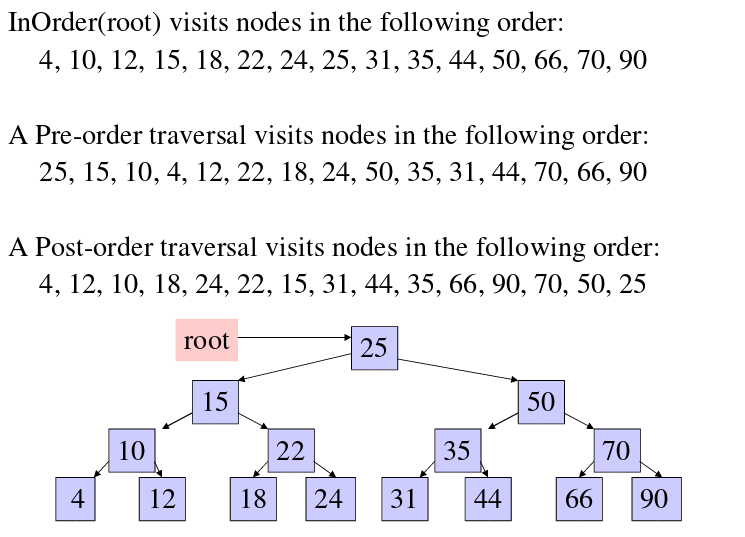原文地址:Tree Traversals
不像线性数据结构(数组,列表,队列,堆栈等),它们在逻辑上只有一种遍历方式,树可以有不同的遍历方式。下面就是遍历树的一般所用的方法:
Algorithm Inorder(tree)
1. Traverse the left subtree, i.e., call Inorder(left-subtree)
2. Visit the root.
3. Traverse the right subtree, i.e., call Inorder(right-subtree)中序遍历应用:
在二叉查询树(BST)中,中序遍历是非递减遍历已知节点。可以通过中序遍历的一个变量得到BST的非递减顺序。
例如:上图的中序遍历是:4 2 5 1 3。
先序遍历:
Algorithm Preorder(tree)
1. Visit the root.
2. Traverse the left subtree, i.e., call Preorder(left-subtree)
3. Traverse the right subtree, i.e., call Preorder(right-subtree) 先序遍历的应用:
先序遍历可以用于建立一个树的拷贝。先序遍历也可以用于在表达式树中获取前缀表达式。请看http://en.wikipedia.org/wiki/Polish_notation就知道为啥前缀表达式是有用的了。
例如:上图的先序遍历是:1 2 4 5 3。
后续遍历:
Algorithm Postorder(tree)
1. Traverse the left subtree, i.e., call Postorder(left-subtree)
2. Traverse the right subtree, i.e., call Postorder(right-subtree)
3. Visit the root.后序遍历的应用:
后续遍历可以用于删除树。请看树的删除问题的详细描述。在一个表达式树中,后序遍历也可以用于获取后缀表达式。请看http://en.wikipedia.org/wiki/Reverse_Polish_notation,后缀表达式的用法。
例如:上图的后序遍历为:4 5 2 3 1。
C语言实现
// C program for different tree traversals
#include <stdio.h>
#include <stdlib.h>
/* A binary tree node has data, pointer to left child
and a pointer to right child */
struct node
{
int data;
struct node* left;
struct node* right;
};
/* Helper function that allocates a new node with the
given data and NULL left and right pointers. */
struct node* newNode(int data)
{
struct node* node = (struct node*)
malloc(sizeof(struct node));
node->data = data;
node->left = NULL;
node->right = NULL;
return(node);
}
/* Given a binary tree, print its nodes according to the
"bottom-up" postorder traversal. */
void printPostorder(struct node* node)
{
if (node == NULL)
return;
// first recur on left subtree
printPostorder(node->left);
// then recur on right subtree
printPostorder(node->right);
// now deal with the node
printf("%d ", node->data);
}
/* Given a binary tree, print its nodes in inorder*/
void printInorder(struct node* node)
{
if (node == NULL)
return;
/* first recur on left child */
printInorder(node->left);
/* then print the data of node */
printf("%d ", node->data);
/* now recur on right child */
printInorder(node->right);
}
/* Given a binary tree, print its nodes in preorder*/
void printPreorder(struct node* node)
{
if (node == NULL)
return;
/* first print data of node */
printf("%d ", node->data);
/* then recur on left sutree */
printPreorder(node->left);
/* now recur on right subtree */
printPreorder(node->right);
}
/* Driver program to test above functions*/
int main()
{
struct node *root = newNode(1);
root->left = newNode(2);
root->right = newNode(3);
root->left->left = newNode(4);
root->left->right = newNode(5);
printf("\nPreorder traversal of binary tree is \n");
printPreorder(root);
printf("\nInorder traversal of binary tree is \n");
printInorder(root);
printf("\nPostorder traversal of binary tree is \n");
printPostorder(root);
getchar();
return 0;
}Java语言实现
// Java program for different tree traversals
/* Class containing left and right child of current
node and key value*/
class Node
{
int key;
Node left, right;
public Node(int item)
{
key = item;
left = right = null;
}
}
class BinaryTree
{
// Root of Binary Tree
Node root;
BinaryTree()
{
root = null;
}
/* Given a binary tree, print its nodes according to the
"bottom-up" postorder traversal. */
void printPostorder(Node node)
{
if (node == null)
return;
// first recur on left subtree
printPostorder(node.left);
// then recur on right subtree
printPostorder(node.right);
// now deal with the node
System.out.print(node.key + " ");
}
/* Given a binary tree, print its nodes in inorder*/
void printInorder(Node node)
{
if (node == null)
return;
/* first recur on left child */
printInorder(node.left);
/* then print the data of node */
System.out.print(node.key + " ");
/* now recur on right child */
printInorder(node.right);
}
/* Given a binary tree, print its nodes in preorder*/
void printPreorder(Node node)
{
if (node == null)
return;
/* first print data of node */
System.out.print(node.key + " ");
/* then recur on left sutree */
printPreorder(node.left);
/* now recur on right subtree */
printPreorder(node.right);
}
// Wrappers over above recursive functions
void printPostorder() { printPostorder(root); }
void printInorder() { printInorder(root); }
void printPreorder() { printPreorder(root); }
// Driver method
public static void main(String[] args)
{
BinaryTree tree = new BinaryTree();
tree.root = new Node(1);
tree.root.left = new Node(2);
tree.root.right = new Node(3);
tree.root.left.left = new Node(4);
tree.root.left.right = new Node(5);
System.out.println("Preorder traversal of binary tree is ");
tree.printPreorder();
System.out.println("\nInorder traversal of binary tree is ");
tree.printInorder();
System.out.println("\nPostorder traversal of binary tree is ");
tree.printPostorder();
}
}输出:
Preorder traversal of binary tree is
1 2 4 5 3
Inorder traversal of binary tree is
4 2 5 1 3
Postorder traversal of binary tree is
4 5 2 3 1另外一个例子:

图片地址:https://www.cs.swarthmore.edu/~newhall/unixhelp/Java_bst.pdf
时间复杂度:O(n)
我们看下不同的边界情况。
函数复杂度 T(n) ——对于遍历说涉及到的所有问题——可以定义为:
T(n) = T(k) + T(n – k – 1) + c
这里根一边的节点的数目,n-k-1是另一边的节点数。
我们分析一下边界条件:
情况1:偏树(Skewed tree)(其中的一个子树为空,而另一边的子树不为空)。
这种情况下k等于0。
T(n)=T(0)+T(n−1)+c
T(n)=2T(0)+T(n−2)+2c
T(n)=3T(0)+T(n−3)+3c
T(n)=4T(0)+T(n−4)+4c
…………………………………………
………………………………………….
T(n)=(n−1)T(0)+T(1)+(n−1)c
T(n)=nT(0)+(n)c
T(0)的值将是一个常数,比如d。(遍历一个空树的时间就是花费常量的时间)
T(n)=n(c+d)
T(n)=Θ(n)(Thetaofn)
情况2:左右子树的节点数目是相同的
T(n)=2T(⌊n/2⌋)+c
这个递归函数对于大师级的方法( http://en.wikipedia.org/wiki/Master_theorem)是标准形式( T(n)=aT(n/b)+(−)(n) )。如果我们用大师方法解决,那么会得到(-)(n)。
空间复杂度:如果我们不考虑栈的大小,那么函数调用是O(1) 否则是O(n)。








 本文介绍了树的三种遍历方法:中序遍历、先序遍历和后序遍历,并给出了它们在二叉查询树、表达式树中的应用。还提供了C语言和Java语言的实现示例,讨论了不同边界情况的时间复杂度,包括偏树和左右子树平衡的情况。
本文介绍了树的三种遍历方法:中序遍历、先序遍历和后序遍历,并给出了它们在二叉查询树、表达式树中的应用。还提供了C语言和Java语言的实现示例,讨论了不同边界情况的时间复杂度,包括偏树和左右子树平衡的情况。














 5517
5517

 被折叠的 条评论
为什么被折叠?
被折叠的 条评论
为什么被折叠?








